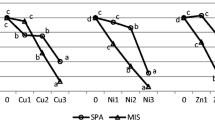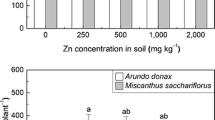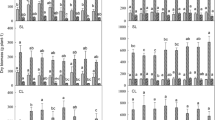Abstract
Giant reed (Arundo donax) and Miscanthus spp. were tested to evaluate their tolerance and phytoremediation capacity in soils contaminated with heavy metals. Giant reed was tested under 450 and 900 mg Zn kg−1, 300 and 600 mg Cr kg−1, and 450 and 900 mg Pb kg−1 contaminated soils, while the Miscanthus genotypes M. × giganteus, M. sinensis, and M. floridulus were tested on 450 and 900 mg Zn kg−1 contaminated soils, along 2 years. Giant reed biomass production was negatively affected by the contamination; however, yield reduction was only significant under 600 mg Cr kg−1 soil. Zn contamination reduced significantly M. × giganteus production but not M. sinensis or M. floridulus yields. Yet, M. × giganteus was also the most productive. Both grasses can be considered as indicators, once metal concentration in the biomass reflected soil metal concentration. Regarding giant reed experiments, higher modified bioconcentration factors (mBCFs, 0.3–0.6) and translocation factors (TFs, 1.0–1.1) were obtained for Zn, in the contaminated soils, followed by Cr (mBCFs, 0.2–0.4, belowground organs; TFs, 0.2–0.4) and Pb (mBCFs, 0.06–0.07, belowground organs; TFs, 0.2–0.4). Metal accumulation also followed the same pattern Zn > Cr > Pb. Miscanthus genotypes showed different phytoremediation potential facing similar soil conditions. mBCFs (0.3–0.9) and TFs (0.7–1.5) were similar among species, but highest zinc accumulation was observed with M. × giganteus due to the higher biomass production. Giant reed and M. × giganteus can be considered as interesting candidates for Zn phytoextraction, favored by the metal accumulation observed and the high biomass produced. A. donax and Miscanthus genotypes showed to be well suited for phytostabilization of heavy metal contamination as these grasses prevented the leaching of heavy metal and groundwater contamination.


Similar content being viewed by others
References
Benjamin M, Honeyman B (1992) Trace metals. In: Butcher S, Charlson R, Orians G, Wolfe G (eds) Global biogeochemical cycles. Academic Press Limited, San Diego, pp 317–352
Alloway B (1995) Heavy metals in soils. Blackie Academic and Professional Publ, United States of America
Kabata-Pendias A (2011) Trace elements in soils and plants, 4th edn. CRC, Boca Raton
Fergusson J (1991) The heavy elements: chemistry, environmental impact and health effects. Pergamon Press, Oxford
Garbisu C, Alkorta I (2003) Basic concepts on heavy metal soil bioremediation. Eur J Miner Process Environ Prot 3:58–66
He Z, Yang X, Stoffella P (2005) Trace elements in agroecosystems and impacts on the environment. J Trace Elem Med Biol 19:125–140
Dauber J, Brown C, Fernando A, Finnan J, Krasuska E, Ponitka J, Styles D, Thrän D, Groenigen K, Weih M, Zah R (2012) Bioenergy from “surplus” land: environmental and socio-economic implications. BioRisk 7:5–50
Wuana RA, Okieimen FE (2011) Heavy metals in contaminated soils: a review of sources, chemistry, risks and best available strategies for remediation. ISRN Ecol. Article ID 402647, doi:10.5402/2011/402647
Ali H, Khan E, Sajad MA (2013) Phytoremediation of heavy metals—concepts and applications. Chemosphere 91:869–881
Nsanganwimana F, Marchland L, Douay F, Mench M (2014) Arundo donax L., a candidate for phytomanaging water and soils contaminated by trace elements and producing plant-based feedstock, a review. Int J Phytoremediation 16:982–1017
Baker A (1981) Accumulators and excluders: strategies in the response of plants to heavy metals. J Plant Nutr 3:643–654
Cunningham S, Ow D (1996) Promises and prospects of phytoremediation. Plant Physiol 110:715–719
Bañuelos G, Zambrzuski S, Mackey B (2000) Phytoextraction of Se from soils irrigated with selenium-laden effluent. Plant Soil 224:251–258
Fernando A, Oliveira J (2004) Fitorremediação de solos contaminados com metais pesados—mecanismos, vantagens e limitações. Biologia Vegetal e Agro-Industrial 1:103–114
Raskin I, Kumar P, Dushenkov S, Salt D (1994) Bioconcentration of heavy metals by plants. Curr Opin Biotechnol 5:285–290
Mulligan C, Yong R, Gibbs B (2001) Remediation technologies for metal-contaminated soils and groundwater: an evaluation. Eng Geol 60:193–207
Yang X, Feng Y, He Z, Stoffella P (2005) Molecular mechanisms of heavy metal hyperacumulation and phytoremediation. J Trace Elem Med Biol 18:339–353
Fernando AL, Godovikova V, Oliveira JFS (2004) Miscanthus × giganteus: contribution to a sustainable agriculture of a future/present-oriented biomaterial. Materials Science Forum, Advanced Materials Forum II 455–456: 437–441
Lasat MM (2000) Phytoextraction of metals from contaminated soil: a review of plant/soil/metal interaction and assessment of pertinent agronomic issues. JHSR 2:1–25
McIntyre T (2003) Phytoremediation of heavy metals from soils. Adv Biochem Eng Biotechnol 78:97–123
Pilon-Smits E (2005) Phytoremediation. Annu Rev Plant Biol 56:15–39
Lewandowski I, Scurlock MOJ, Lindvall E, Christou M (2003) The development and current status of perennial rhizomatous grasses as energy crops in the US and Europe. Biomass Bioenergy 25:335–361
El Bassam N (2010) Handbook of bioenergy crops. A complete reference to species, development and applications. Earthscan, London
Papazoglou E, Karantounias G, Vemmos S, Bouranis D (2005) Photosynthesis and growth responses of giant reed (Arundo donax L.) to the heavy metals Cd and Ni. Environ Int 31:243–249
ALAC F (2005) Fitorremediação por Miscanthus × giganteus de solos contaminados com metais pesados, Ph.D. thesis. Faculdade de Ciências e Tecnologia, Universidade Nova de Lisboa, Portugal (in Portuguese)
Fernando AL, Duarte MP, Almeida J, Boléo S, Mendes B (2010) Environmental impact assessment of energy crops cultivation in Europe. Biofuels Bioprod Biorefin 4:594–604
Zhang Y, Li Y, Jiang L, Tian C, Li J, Xiao Z (2011) Potential of perennial crop on environmental sustainability of agriculture. Procedia Environ Sci 10:1141–1147
Barbosa B, Costa J, Fernando AL, Papazoglou EG (2015) Wastewater reuse for fiber crops cultivation as a strategy to mitigate desertification. Ind Crop Prod 68:17–23
Barbafieri M, Dadea C, Tassi E, Bretzel F, Fanfani L (2011) Uptake of heavy metals by native species growing in a mining area in Sardinia, Italy: discovering native flora for phytoremediation. Int J Phytoremediation 13:985–997
Boularbah A, Schwartz C, Bitton G, Aboudrar W, Ouhammou A, Morel JL (2006) Heavy metal contamination from mining sites in South Morocco: 2. assessment of metal accumulation and toxicity in plants. Chemosphere 63:811–817
Fernando A, Oliveira JS (2004) Effects on growth, productivity and biomass quality of Miscanthus × giganteus of soils contaminated with heavy metals. In: Van Swaaij, WPM, Fjällström T, Helm P, Grassi A (eds) Biomass for Energy, Industry and Climate Protection: Proceedings of the 2nd World Biomass Conference, ETA-Florence e WIP-Munich, pp 387–390
Kausar S, Mahmood Q, Raja IA, Khan A, Sultan S, Gilani MA, Shujaat S (2012) Potential of Arundo donax to treat chromium contamination. Ecol Eng 42:256–259
Pilu R, Bucci A, Badone FC, Landoni M (2012) Giant reed (Arundo donax L.): a weed plant or a promising energy crop? Afr J Biotechnol 11:9163–9174
Decreto-Lei n.°276-2009 (2009) Anexo I, Valores limite de concentração relativos a metais pesados, compostos orgânicos e dioxinas e microrganismos. Diário da República 192:7154–7165 (in Portuguese)
Dyckhoff C, Halliwell L, Haynes R, Watts S (1996) Sampling. In: Watts S, Halliwell L (eds) Essential environmental science, methods and techniques. Routledge, London, pp 31–66
Baize D (2000) Guide des analyses en pedologie, 2nd edn. INRA editions, Paris
Ross DS, Ketterings Q (2011) Recommended methods for determining soil cation exchange capacity—Chapter 9. Recommended Soil Testing Procedures for the Northeastern United States. Cooperative Bulletin No. 493. Available at http://extension.udel.edu/lawngarden/files/2012/10/CHAP9.pdf.
Walkley A, Black IA (1934) An examination of the Degtjareff method for determining soil organic matter and a proposed modification of the chromic acid titration method. Soil Sci 34:29–38
Watts S, Halliwell L (1996) Appendix 3—detailed field and chemical methods for soil. In: Watts S, Halliwell L (eds) Essential environmental science, methods and techniques. Routledge, London, pp 475–505
Haigh M, Dyckhoff C (1996) Soils. In: Watts S, Halliwell L (eds) Essential environmental science, methods & techniques. Routledge, London, pp 261–303
Olsen SR, Cole CV, Watanabe FS, Dean LA (1954) Estimation of available phosphorus in soils by extraction with sodium bicarbonate. United States Department of Agriculture (USDA) Circular 939. U.S. Government Printing Office, Washington
Watanabe FS, Olsen SR (1965) Test of an ascorbic acid method for determining phosphorus in water and NaHCO3 extracts from the soil. Proc Soil Sci Soc Am 29:677–678
ISO 11466 (1995) Soil quality—extraction of trace metals soluble in aqua regia
Iqbal M, Bermond A, Lamy I (2013) Impact of miscanthus cultivation on trace metal availability in contaminated agricultural soils: complementary insights from kinetic extraction and physical fractionation. Chemosphere 91:287–294
Vandecasteele C, Block CB (1993) Modern methods for trace element determination. Wiley, Chichester
Kumar GP, Yadav SK, Thawale PR, Singh SK, Juwarkar AA (2008) Growth of Jatropha curcas on heavy metal contaminated soil amended with industrial wastes and Azotobacter—a greenhouse study. Bioresour Technol 99:2078–2082
Yadav SK, Juwarkar AA, Kumar GP, Thawale PR, Singh SK, Chakrabarti T (2009) Bioaccumulation and phyto-translocation of arsenic, chromium and zinc by Jatropha curcas L.: impact of dairy sludge and biofertilizer. Bioresour Technol 100:4616–4622
Ghosh S, Singh P (2005) Comparative uptake and phytoextraction study of soil induced chromium by accumulator and high biomass weed species. Appl Ecol Environ Res 3:67–79
Mattina MJI, Lannucci-Berger W, Musante C, White JC (2003) Concurrent plant uptake of heavy metals and persistent organic pollutants from soil. Environ Pollut 124:375–378
Guo ZH, Miao XF (2010) Growth changes and tissues anatomical characteristics of giant reed (Arundo donax L.) in soil contaminated with arsenic, cadmium and lead. J Cent S Univ Technol 17:770–777
Nsanganwimana F, Pourrut B, Mench M, Douay F (2014) Suitability of Miscanthus species for managing inorganic and organic contaminated land and restoring ecosystem services. A review. J Environ Manag 143:123–134
Mirza N, Mahmood Q, Pervez A, Ahmad R, Farooq R, Shah MM, Azim MR (2010) Phytoremediation potencial of Arundo donax in arsenic-contaminated synthetic wastewater. Bioresour Technol 101:5815–5819
Leung HM, Ye ZH, Wong MH (2007) Survival strategies of plants associated with arbuscular mycorrhizal fungi on toxic mine tailings. Chemosphere 66:905–915
Kacprzak MJ, Rosikon K, Fijalkowski K, Grobelak A (2014) The effect of Trichoderma on heavy metal mobility and uptake by Miscanthus giganteus, Salix sp., Phalaris arundinacea, and Panicum virgatum. Appl Environ Soil Sci, Article ID 506142, doi:10.1155/2014/506142
Jin X, You S (2015) Soil pollution of abandoned tailings in one zinc antimony mine and heavy metal accumulation characteristics of dominant plants. International Conference on Materials, Environmental and Biological Engineering, Guilin, pp 500–504, March 28–30, MEBE (2015)
Barbosa B, Costa J, Boléo S, Duarte MP, Fernando AL (2016) Phytoremediation of inorganic compounds. In: Ribeiro AB, Mateus EP, Couto N (eds) Electrokinetics across disciplines and continents—new strategies for sustainable development. Springer International Publishing, Switzerland, pp 373–400
Fiorentino N, Fagnano M, Adamo P, Impagliazzo A, Mori M, Pepe O, Ventorino V, Zoina A (2013) Assisted phytoextraction of heavy metals: compost and Trichoderma effects on giant reed (Arundo donax L.) uptake and soil N-cycle microflora. Ital J Agron 8:244–254
Sabeen M, Mahmood Q, Irshad M, Fareed I, Khan A, Ullah F, Hussain J, Hayat Y, Tabassum S (2013) Cadmium phytoremediation by Arundo donax L. from contaminated soil and water. Int J Biomed Res. Article ID 324830, doi:10.1155/2013/324830
Pulford ID, Watson C (2003) Phytoremediation of heavy metal-contaminated land by trees—a review. Environ Int 29:529–540
Decreto Lei n° 236/98 (1998) Normas, critérios e objectivos de qualidade com a finalidade de proteger o meio aquático e melhorar a qualidade das águas em função dos seus principais usos, Diário da República 176: 3676–3722 (in Portuguese).
Acknowledgments
The authors would like to acknowledge the European Union for financially supporting this work through the Optimization of Perennial Grasses for Biomass Production (OPTIMA) project, Grant Agreement No. 289642, Collaborative project, FP7-KBBE-2011.3.1-02.
Author information
Authors and Affiliations
Corresponding author
Rights and permissions
About this article
Cite this article
Barbosa, B., Boléo, S., Sidella, S. et al. Phytoremediation of Heavy Metal-Contaminated Soils Using the Perennial Energy Crops Miscanthus spp. and Arundo donax L.. Bioenerg. Res. 8, 1500–1511 (2015). https://doi.org/10.1007/s12155-015-9688-9
Published:
Issue Date:
DOI: https://doi.org/10.1007/s12155-015-9688-9




